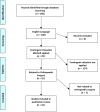Contingent Valuation Studies in Orthopaedic Surgery: A Health Economic Review
- PMID: 30258339
- PMCID: PMC6148581
- DOI: 10.1007/s11420-018-9610-z
Contingent Valuation Studies in Orthopaedic Surgery: A Health Economic Review
Abstract
Background: A greater emphasis on providing high-value orthopaedic interventions has resulted in increased health economic reporting. The contingent-valuation method (CVM) is used to determine consumer valuation of the benefits provided by healthcare interventions. CVM is an important value-based health economic tool that is underutilized in orthopaedic surgery.
Questions/purposes: The purpose of this study was to (1) identify previously published CVM studies in the orthopaedic literature, (2) assess the methodologies used for CVM research, and (3) understand how CVM has been used in the orthopaedic cost-benefit analysis framework.
Methods: A systematic review of the literature using the MEDLINE database was performed to compile CVM studies. Search terms incorporated the phrase willingness to pay (WTP) or willingness to accept (WTA) in combination with orthopaedic clinical key terms. Study methodology was appraised using previously defined empirical and conceptual criteria for CVM studies.
Results: Of the 160 studies retrieved, 22 (13.8%) met our inclusion criteria. The economics of joint arthroplasty (n = 6, 27.3%) and non-operative osteoarthritis care (n = 4, 18.2%) were the most common topics. Most studies used CVM for pricing and/or demand forecasting (n = 16, 72.7%); very few studies used CVM for program evaluation (n = 6). WTP was used in all included studies, and one study used both WTP and WTA. Otherwise, there was little consistency among included studies in terms of CVM methodology. Open-ended questioning was used by only ten studies (45.5%), a significant number of studies did not perform a sensitivity analysis (n = 9, 40.9%), and none of the studies accounted for the risk preference of subjects. Only two of the included studies applied CVM within a cost-benefit analysis framework.
Conclusion: CVM is not commonly reported in orthopaedic surgery and is seldom used in the context of cost-benefit analysis. There is wide variability in the methods used to perform CVM. We propose that CVM is an appropriate and underappreciated method for understanding the value of orthopaedic interventions. Increased attention should be paid to consumer valuations for orthopaedic interventions.
Keywords: contingent valuation method; cost-effectiveness analysis; cost–benefit analysis; willingness to pay.
Conflict of interest statement
Benedict U. Nwachukwu, MD, MBA, Claire D. Eliasberg, MD, Kamran S. Hamid, MD, MPH, Michael C. Fu, MD, MHS, Bernard R. Bach, MD, and Answorth A. Allen, MD, declare that they have no conflicts of interest. Todd J. Albert, MD, reports royalties from DePuy Synthes and Facet Link; investment interest in Biomerix, Crosstrees Medical, Gentis, International Orthopaedic Alliance, InVivo Therapeutics, Invuity, Paradigm Spine, Pulse Equity, and Spinicity; stock options in Vital 5; personal fees from Zimmer Biomet and Lineum Cervical System and Polaris Spinal System; and medical advisory board membership at United Healthcare, outside the submitted work.N/AN/ADisclosure forms provided by the authors are available with the online version of this article.
Figures
Similar articles
-
Health care contingent valuation studies: a review and classification of the literature.Health Econ. 1998 Jun;7(4):313-26. doi: 10.1002/(sici)1099-1050(199806)7:4<313::aid-hec350>3.0.co;2-b. Health Econ. 1998. PMID: 9683092 Review.
-
Willingness to pay for public health services in rural Central Java, Indonesia: methodological considerations when using the contingent valuation method.Soc Sci Med. 2014 Jun;110:31-40. doi: 10.1016/j.socscimed.2014.03.025. Epub 2014 Mar 26. Soc Sci Med. 2014. PMID: 24713191
-
[Contingent valuation for health care services. Review of domestic studies and outline of foreign investigations].Nihon Koshu Eisei Zasshi. 2006 Nov;53(11):818-30. Nihon Koshu Eisei Zasshi. 2006. PMID: 17228751 Review. Japanese.
-
A cost-benefit analysis using contingent valuation techniques: a feasibility study in spinal surgery.Value Health. 2008 Jul-Aug;11(4):575-88. doi: 10.1111/j.1524-4733.2007.00282.x. Epub 2007 Dec 19. Value Health. 2008. PMID: 18179657
-
A Systematic Review of WTA-WTP Disparity for Dental Interventions and Implications for Cost-Effectiveness Analysis.Healthcare (Basel). 2020 Aug 26;8(3):301. doi: 10.3390/healthcare8030301. Healthcare (Basel). 2020. PMID: 32858834 Free PMC article.
Cited by
-
Trends and Themes in the Study of Value in Orthopedic Surgery: A Systematic Review.HSS J. 2025 Feb;21(1):93-101. doi: 10.1177/15563316231204040. Epub 2023 Oct 24. HSS J. 2025. PMID: 39846060 Free PMC article. Review.
References
-
- Cost-benefit and other analysis requirements in the rulemaking process 2014. Congressional Research Service. Available athttps://fas.org/sgp/crs/misc/R41974.pdf. Accessed July 4, 2017.
-
- Alolabi B, Bajammal S, Shirali J, Karanicolas PJ, Gafni A, Bhandari M. Treatment of displaced femoral neck fractures in the elderly: a cost-benefit analysis. J Orthop Trauma. 2009;23:442–446. - PubMed
-
- Arrow K, Solow R, Portney PR, Leamer EE, Radner R, Schuman H. Report of the NOAA Panel on Contingent Valuation. 1993. Available at:https://sites.google.com/site/economiayambiente/PanelNOAA.pdf. Accessed July 4, 2017.
-
- Birch S, Donaldson C. Valuing the benefits and costs of health care programmes: where’s the “extra” in extra-welfarism? Soc Sci Med. 2003;56:1121–1133. - PubMed
-
- Bozic KJ, Chiu V, Slover JD, Immerman I, Kahn JG. Patient preferences and willingness to pay for arthroplasty surgery in patients with osteoarthritis of the hip. J Arthroplasty. 2012;27:503–506.e502. - PubMed
Publication types
LinkOut - more resources
Full Text Sources
Other Literature Sources
Miscellaneous


